Introduction
Understanding Wholesale VoIP rates can help US-based carriers and resellers save money on their communication costs. The world of VoIP (Voice over Internet Protocol) is growing rapidly, and as a result, navigating the landscape of wholesale pricing is becoming increasingly important. VoIP enables voice calls using the internet, offering a cost-effective and flexible alternative to traditional telephony.
Wholesale VoIP rates involve buying large volumes of call services at reduced prices, which can significantly lower communication expenses. As demand for these services increases, the competitive US market influences these rates. Factors affecting the rates include the underlying technology, market competition, and the complex US regulatory environment.
More businesses are turning to Wholesale VoIP solutions for their scalability and affordability. Understanding how these rates work and the associated benefits can give your company a competitive edge. This guide will break down the key factors for US carriers and resellers.
Understanding VoIP Wholesale Rates
Wholesale VoIP rates determine the cost telecom companies and resellers pay to handle large volumes of calls over the internet. These rates directly affect retail pricing strategies and the competitive landscape of telecommunications in the United States.
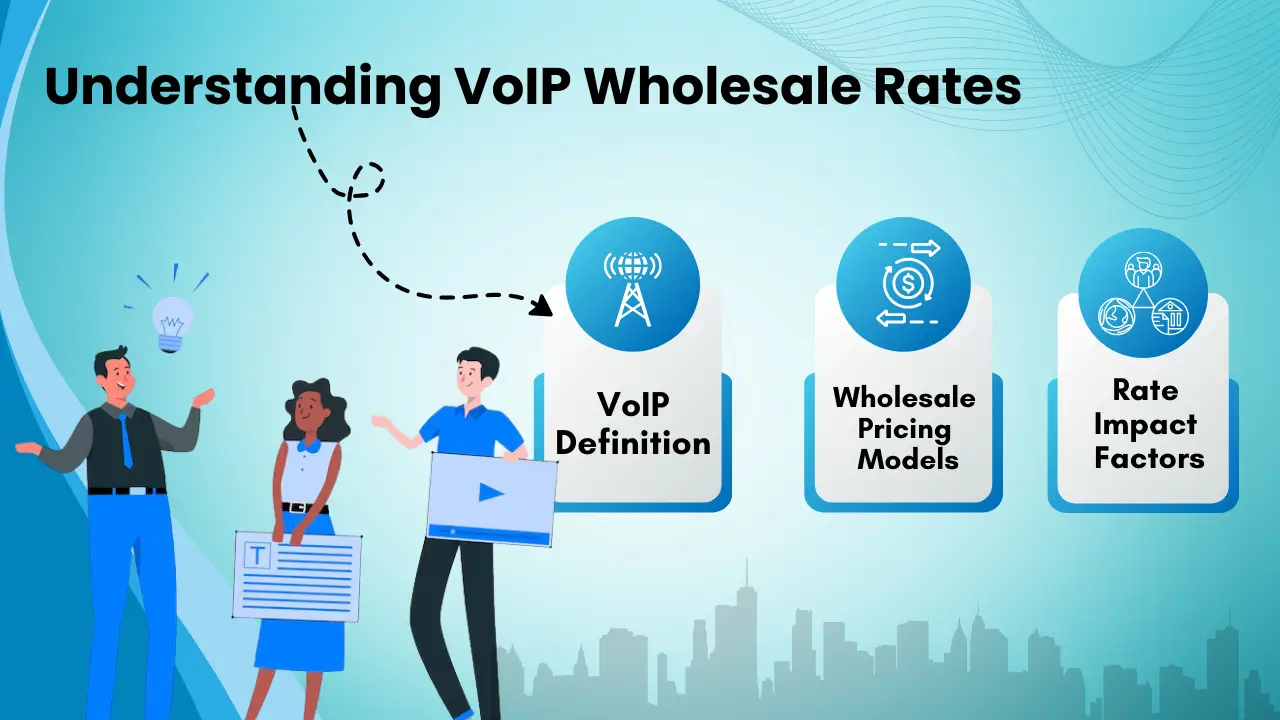
Definition of VoIP
VoIP, or Voice over Internet Protocol, is a technology that allows voice communication to be carried out over the internet instead of traditional phone lines. It converts analog voice signals into digital data packets for transmission. This technology offers the advantage of reduced costs and the flexibility to communicate globally, supporting various functions like video calls and instant messaging, making it a versatile communication tool.
Wholesale VoIP Overview
Wholesale VoIP is the business model of selling VoIP services, such as call termination and DIDs, in large quantities to other businesses or resellers. These resellers then provide services to their end-users. The pricing model often depends on the number of minutes, channels, or data volume handled. For US providers, offering competitive Wholesale VoIP rates is essential for capturing market share, but this must be balanced with the costs of maintaining a high-quality, compliant network.
Factors Influencing VoIP Pricing
VoIP pricing is shaped by several key factors, from the foundational cost structures to the dynamic interplay of market forces. Each element plays a crucial role in determining the final rates for Wholesale VoIP services.
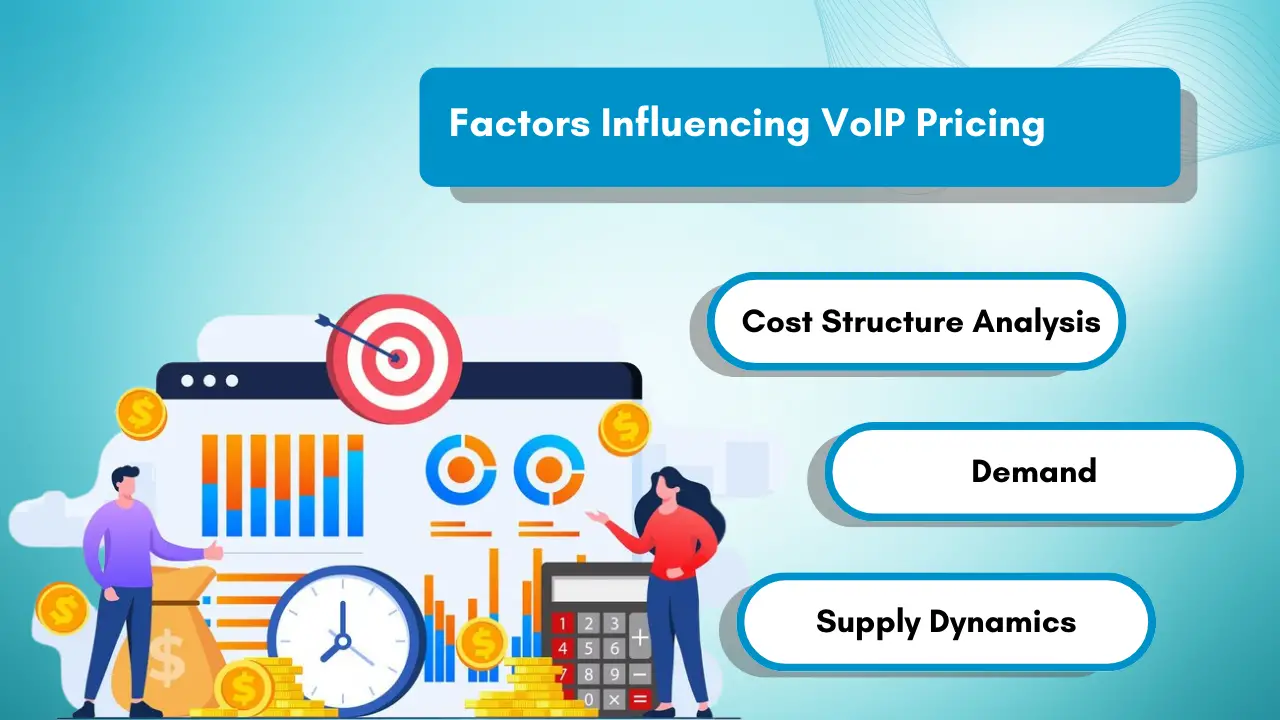
Cost Structure Analysis
The cost of providing Wholesale VoIP services includes several core components. Infrastructure costs are significant, covering servers, network switches, and ongoing maintenance. Bandwidth costs are also a major factor, as high-speed, low-latency internet is necessary to provide clear, reliable call quality. Finally, there are interconnection fees paid to other carriers to terminate calls on their networks.
Demand and Supply Dynamics
Dynamics Wholesale VoIP pricing is greatly influenced by market demand and supply. High demand for services, driven by the shift from traditional telephony, allows providers to maintain stable pricing. The supply side is affected by the number of providers in the market; more competition typically leads to lower rates. This dynamic ensures that pricing remains competitive while reflecting the true cost of service delivery.
Comparing VoIP Wholesale Rates
Wholesale VoIP rates can vary widely between providers. Understanding how to benchmark these rates and balance quality against price is key for making an informed decision for your business.
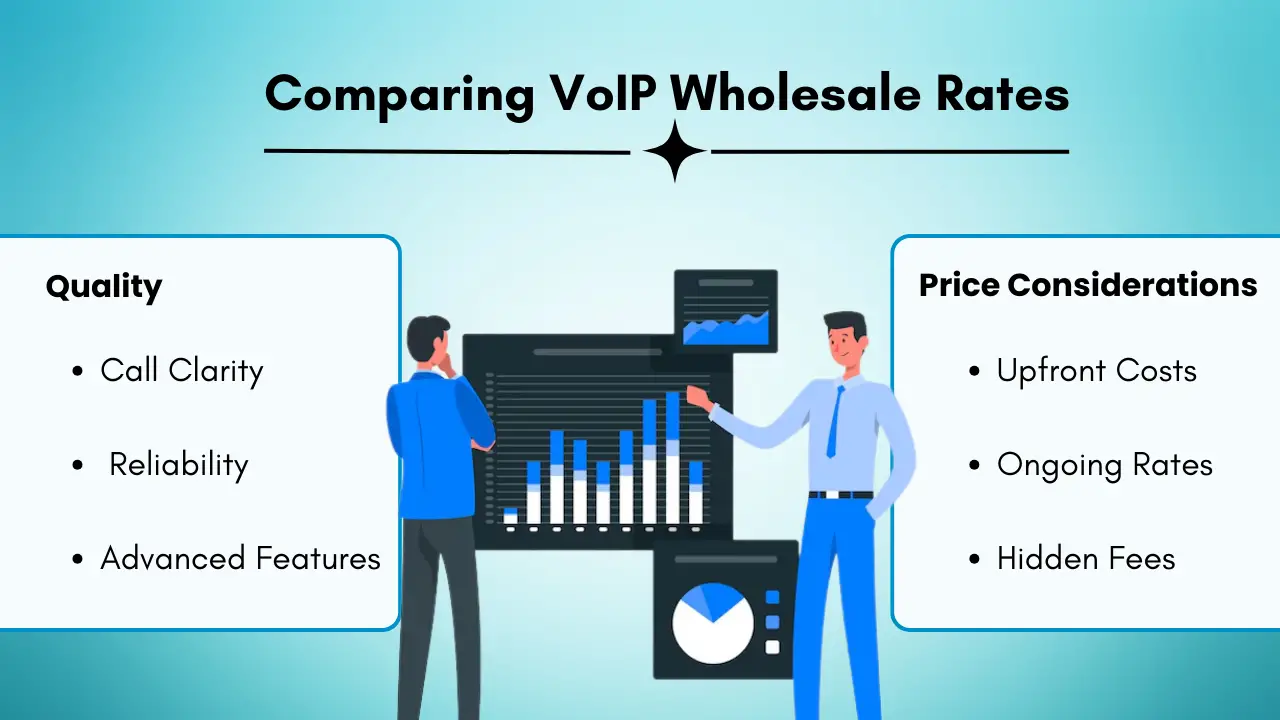
Rate Benchmarking
Finding the right VoIP termination rates involves comparing different providers. Businesses should look for competitive prices by evaluating current market trends and obtaining rate decks from multiple wholesalers. It’s crucial to look beyond the advertised price per minute and check for hidden fees, surcharges, or minimum volume commitments that can affect the total cost. A transparent pricing structure is a hallmark of a reputable provider.
Quality vs. Price Considerations
The balance between quality and cost is critical. A lower rate might save money upfront but could lead to poor call quality, low Answer-Seizure Ratio (ASR), and connectivity issues that damage your brand’s reputation. Higher-quality service may come at a slightly higher rate but ensures fewer dropped calls, better audio clarity, and overall reliability. US resellers should prioritize providers who guarantee high-quality service, even if it’s not the absolute lowest price on the market.
Negotiating VoIP Rates
Negotiating VoIP rates can significantly impact your business’s profitability. This process involves a clear understanding of contractual agreements and leveraging commitments to secure discounts.

Contractual Agreements
When sourcing VoIP termination services, you will enter into contracts that outline the terms, rates, and Service Level Agreements (SLAs). It is essential to carefully review details regarding pricing structure, service uptime guarantees, and any clauses related to additional fees or surcharges. Negotiate terms that offer the flexibility to scale services as your usage changes and ensure the contract has clear language on support and dispute resolution.
Volume Discounts and Commitments
Wholesale VoIP providers often offer volume discounts to businesses that commit to a high volume of monthly minutes. By committing to more usage, companies can negotiate lower per-minute rates, which represents significant savings. Signing a long-term commitment can also lead to better pricing, but be sure to balance the savings against your need for flexibility, ensuring any long-term agreement aligns with your projected growth.
Billing Models for VoIP Services
VoIP services use different billing models to offer flexibility. The two most common models in the wholesale market are per-minute rate structures and monthly subscription plans, each catering to different business needs.
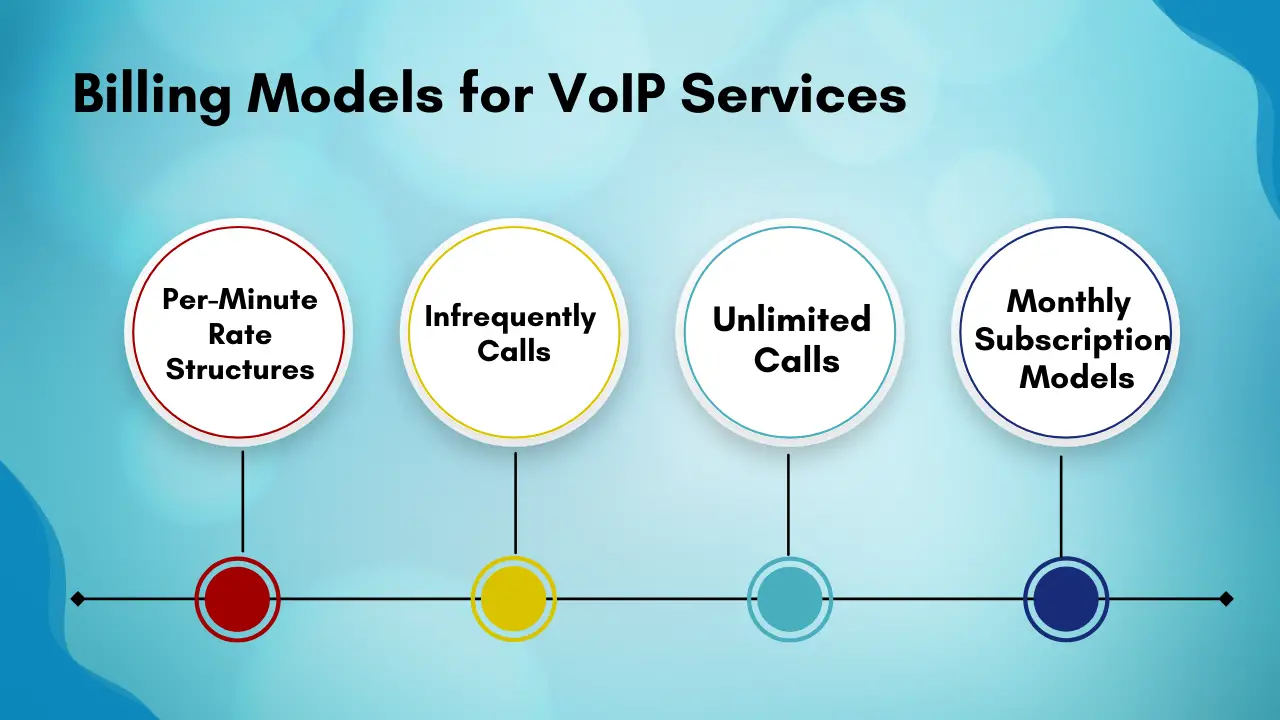
Per-Minute Rate Structures
In this model, you are charged based on the number of minutes used. This approach is beneficial for businesses with fluctuating traffic or those who need granular control over costs. The rate varies depending on the call destination (e.g., domestic US vs. international) and the specific rate deck. This pay-as-you-go model provides transparency, as you only pay for what you use.
Monthly Subscription Models
The monthly subscription model, often called channel-based pricing, offers a flat rate for a set number of concurrent calls (channels). This is ideal for businesses with predictable, high-volume communication needs, as it simplifies budgeting. These plans often come with the assumption of high usage, providing cost certainty without the need to track individual call durations.
Technological Impact on Rates
Technological advancements in VoIP have a significant impact on wholesale rates. Innovations in software and network infrastructure play key roles in improving efficiency and driving down costs.
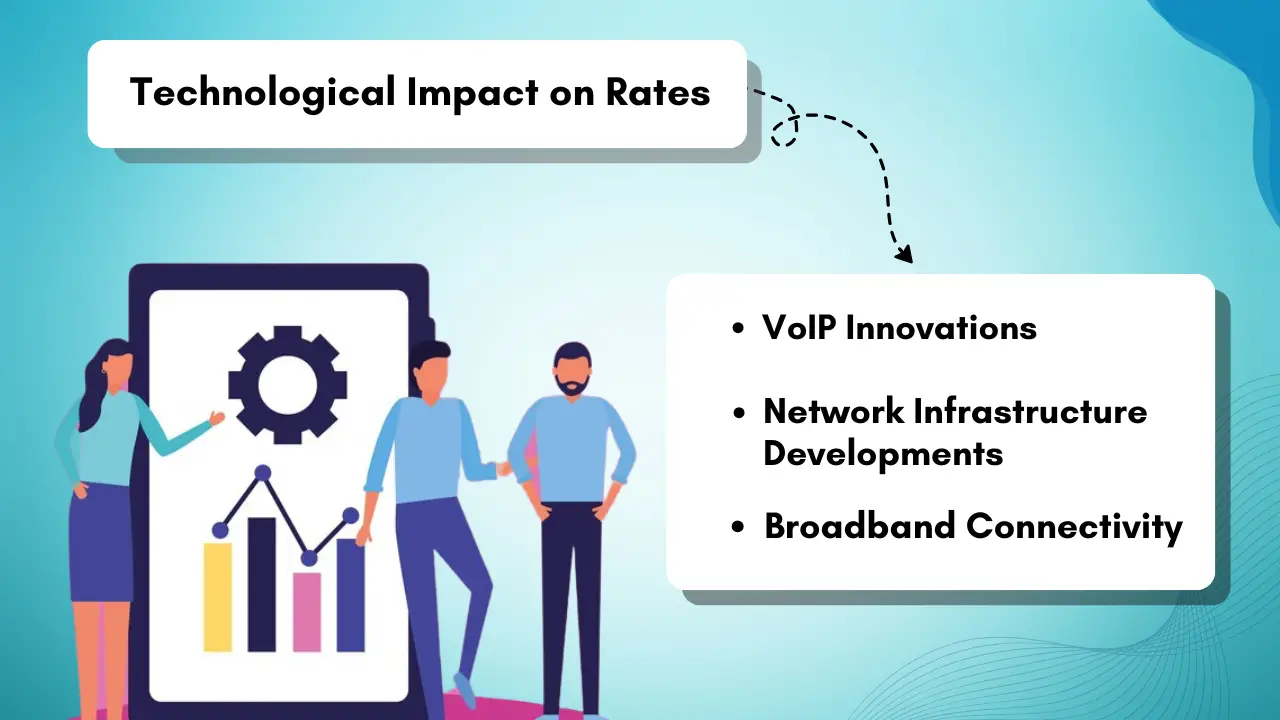
VoIP Innovations
Key innovations in VoIP technology directly influence provider costs and, consequently, wholesale rates. Advanced codec technology (like Opus) compresses audio data more efficiently without sacrificing quality, reducing bandwidth consumption. Furthermore, the rise of cloud-based platforms has dramatically lowered the infrastructure costs for providers, as they can scale operations in geo-redundant data centers and pass those savings on to customers.
Network Infrastructure Developments
Modern network infrastructure is crucial for high-quality, cost-effective VoIP. Improvements in fiber optic connectivity have enhanced performance by ensuring high-speed, reliable connections. Technologies like Software-Defined Networking (SDN) allow providers to optimize data routing dynamically, lowering operational costs. The continued rollout of 5G also promises to enhance mobile VoIP quality with higher bandwidth and reduced latency, supporting seamless communication and potentially pushing rates down further.
VoIP Rate Variations by Region
While VoIP is global, rates and regulations differ significantly by region. For US carriers and resellers, understanding the domestic regulatory landscape is far more critical than international rate patterns.

International Rate Patterns
Rates for international calls vary widely based on the destination country’s local costs, competition, and regulations. While providers offer extensive international rate decks, a US reseller’s primary focus will be on competitive and high-quality domestic US termination rates. A provider’s ability to handle US traffic efficiently is the most important regional consideration.
Regional Regulatory Considerations
Considerations For US carriers, the domestic regulatory landscape is the most significant regional factor affecting cost and operations. Compliance is non-negotiable. Key US considerations include:
- STIR/SHAKEN: Providers must comply with this FCC-mandated framework to combat illegal call spoofing. Failure to do so can result in blocked calls and fines.
- FCC Regulations & USF: Providers must often contribute to the Universal Service Fund (USF), and these regulatory fees are factored into the overall cost structure.
- E911 Services: Offering reliable E911 call routing is a legal requirement for most VoIP services in the US.
CALEA: The Communications Assistance for Law Enforcement Act requires providers to have the technical capability to support law enforcement surveillance requests.
Selecting a VoIP Wholesale Provider
Choosing the right VoIP wholesale provider is a critical decision. US resellers must evaluate providers based on specific compliance criteria and aim to build a beneficial long-term partnership.
Provider Assessment Criteria
When selecting a Wholesale VoIP provider, US businesses must prioritize several key factors. Network reliability and uptime guarantees are fundamental. Beyond that, confirm the provider is fully compliant with all US regulations, including STIR/SHAKEN call attestation and E911 services. Evaluate their customer support availability (24/7 is standard) and the functionality of their self-service portal for managing rates and DIDs.
Building Strategic Partnerships
Building a strategic relationship with your VoIP wholesaler is more than just a transactional arrangement. Establish clear communication channels to stay informed about rate changes and new compliance requirements. A good partner will work with you to find custom solutions that meet your needs and will be transparent about their network performance and quality metrics, fostering a cooperative relationship that leads to sustainable growth.
Future Trends in VoIP Rates
The landscape of Wholesale VoIP rates is constantly evolving. Key trends for US resellers include a focus on security and compliance, along with the influence of emerging technologies like 5G and AI.
Predicting Rate Fluctuations
While market competition will keep rates competitive, costs associated with compliance and fighting fraud are likely to be a factor. As regulatory requirements from the FCC become stricter, providers will invest more in technology to meet them, which can influence the cost basis for services. Rates for high-quality, fully compliant traffic will remain stable and valuable.
The Impact of Emerging Technologies
The rollout of 5G will continue to improve the quality and reliability of VoIP over mobile networks. More importantly, Artificial Intelligence (AI) is becoming a game-changer for fraud detection, allowing providers to identify and block fraudulent call traffic in real-time. This not only protects the network but also saves resellers from costly chargebacks associated with illicit traffic.
Practices for VoIP Resellers
Successful US VoIP resellers focus on maximizing profit margins while ensuring strict adherence to quality and regulatory compliance, which is essential for customer satisfaction.
Maximizing Profit Margins
To maximize profit margins, negotiate effectively with wholesale providers by leveraging your volume and understanding market rates. Offer value-added services on top of basic voice calling, such as hosted PBX features, analytics, or CRM integrations. Using an efficient, reliable network reduces troubleshooting costs and customer churn, directly protecting your bottom line.
Quality Assurance and Customer Satisfaction
Customer satisfaction in the US market is built on trust and reliability. Maintain high service quality by partnering with a wholesaler that provides excellent call quality (low latency, high ASR). Ensure your services are fully compliant with all FCC regulations, especially E911 and STIR/SHAKEN. Offering robust, responsive customer support is key to building a loyal customer base and a strong reputation.
Conclusion
Wholesale VoIP rates are a crucial component of success for US carriers and resellers. Understanding these rates requires looking beyond the price per minute to consider factors like US regulatory compliance, network quality, and provider reliability. By carefully evaluating these elements and staying informed about market trends, companies can select services that meet their needs while maintaining cost-effectiveness and a strong competitive position.
FAQ's
What factors affect VoIP wholesale rates?
VoIP wholesale rates are influenced by infrastructure costs, bandwidth requirements, market competition, regional regulations, call volume commitments, and the provider’s network quality and reliability.
How do regional differences impact VoIP wholesale rates?
Regional variations in infrastructure, local regulations, market competition, and international traffic patterns directly affect VoIP wholesale rates in different geographical areas.
What's the difference between per-minute and subscription billing models?
Per-minute billing charges based on actual usage, while subscription models offer a fixed rate for predetermined minutes. Each suits different business needs and call patterns.
How important is service quality when selecting a VoIP wholesale provider?
Service quality is crucial as it affects call clarity, reliability, and customer satisfaction. Good providers balance competitive rates with consistent service performance.
What should businesses look for in VoIP wholesale contracts?
Businesses should examine rate structures, service level agreements, quality guarantees, volume commitments, contract duration, and potential hidden fees before signing.





